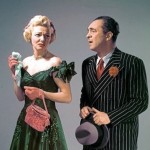From the Mississippi River banks to the Oklahoma plains, and beyond, the best musicals effectively evoke their settings. Guys and Dolls was the first (and so far best) Broadway musical to bring Broadway to life — not the Broadway of bright lights and theater marquees but the Broadway of streetlights and after-hours clubs — and with infectious affection. As director Jerry Zaks told NPR, “I use the word ‘joy’ a lot, but that’s what I think the show is all about: a kind of infectious joy that makes you just want to join them up there on stage.”
The idea began with producers Cy Feuer and Ernest Martin, who wanted to bring the world created by Damon Runyon to the stage. They hired Frank Loesser to write the score and Jo Swerling to write the book. The producers found the first version of Swerling’s book unusable, so they asked Abe Burrows to step in. The challenge was, though, that Loesser had already written much of the score by then. Burrows later wrote, “Loesser’s fourteen songs were all great, and the [new book] had to be written so that the story would lead into each of them.”
During its tryout in Philadelphia, every performance saw new changes. “About 1:00 in the morning, Frank called me,” actor Isabel Bigley recalled, “and we worked on [a new song] till about 5:00 in the morning. … We put it in the matinee.” Actor Robert Alda said, “Forty of the 41 shows were completely different. In other words, we continuously were making changes.”
The main story line is from “The Idyll of Miss Sarah Brown,” in which a gambler Sky Masterson takes a bet that he can make any woman fall in love with him. The woman of his current conquest is missionary Sarah Brown. (You can listen to a 1949 radio episode of the story here.) The subplot involves gambler Nathan Detroit and his longtime fiancée Adelaide.
The role of Adelaide was created specifically to fit Vivian Blaine’s talents, as was the role of Nathan to suit Sam Levene, who was a great actor but a bad singer. Loesser adjusted the score to accommodate Levene’s limitations, which is why Nathan has only one song: the duet “Sue Me.” Loesser also structured the song so that Levene and Blaine never sang at the same time during the duet.
The show premiered in New York on November 24, 1950, starring Robert Alda (Sky), Sam Levene (Nathan), Isabel Bigley (Sarah), and Vivian Blaine (Adelaide), with direction by George S. Kaufman and choreography by Michael Kidd. It ran for 1,200 performances and won five Tonys: best musical, leading actor (Alda), featured actress (Bigley), choreography, and direction. New York Journal American critic John McClain wrote, “It is the best and most exciting thing of its kind since Pal Joey.” New York Times critic Brooks Atkinson simply said, “It is a work of art.”
Guys and Dolls was chosen as the winner of the 1950 Pulitzer Prize for Drama. However, because Burrows was on the Red Channels “black list,” the trustees of Columbia University vetoed the drama committee’s selection, and no prize was awarded that year.
The musical received a 1955 film adaptation starring Marlon Brando (Sky), Jean Simmons (Sarah), Frank Sinatra (Nathan), and Vivian Blaine (reprising the role of Adelaide). Another original cast member reprising their role was Stubby Kaye as Nicely-Nicely Johnson, who sings the show-stopping production number “Sit Down, You’re Rockin’ the Boat.” The film was directed by Joseph L. Mankiewicz, who co-wrote the screenplay with Ben Hecht.
The 1992 revival was the most successful Broadway return, running for 1,143 performances. Directed by Jerry Zaks, it starred Nathan Lane (Nathan), Peter Gallagher (Sky), Faith Prince (Adelaide) and Josie de Guzman (Sarah).
The original cast recording was inducted into the Grammy Hall of Fame in 1998. In addition to that version, the 1992 revival cast is worth a listen. To learn about the creation of the show, read Keith Garebian’s The Making of Guys and Dolls (2010). For more, try producer Cy Feuer’s 2003 autobiography I Got the Show Right Here.
NEXT, for a backstage look at the Broadway theater world, listen to Kiss Me, Kate (1948), written by Bella and Samuel Spewack (book) and Cole Porter (music and lyrics), about the professional (and personal) complications of a Broadway-bound musical adaptation of The Taming of the Shrew.
THEN, for another story about unlikely love in which opposites attract (this time a union rep and factory superintendent), listen to The Pajama Game (1954), written by Richard Bissell and George Abbott (book) and Richard Adler and Jerry Ross (music and lyrics).

